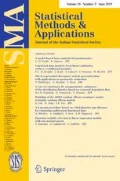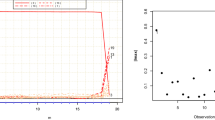Abstract
The local influence method has proven to be a useful and powerful tool for detecting influential observations on the estimation of model parameters. This method has been widely applied in different studies related to econometric and statistical modelling. We propose a methodology based on the Lagrange multiplier method with a linear penalty function to assess local influence in the possibly heteroskedastic linear regression model with exact restrictions. The restricted maximum likelihood estimators and information matrices are presented for the postulated model. Several perturbation schemes for the local influence method are investigated to identify potentially influential observations. Three real-world examples are included to illustrate and validate our methodology.









Similar content being viewed by others
References
Atkinson AC, Riani M (2000) Robust diagnostic regression analysis. Springer, Berlin
Atkinson AC, Riani M, Cerioli A (2004) Exploring multivariate data with the forward search. Springer, Berlin
Barros M, Galea M, González M, Leiva V (2010) Influence diagnostics in the tobit censored response model. Stat Methods Appl 19:379–397
Billor N, Loynes RM (1993) Local influence: a new approach. Commun Stat Theory Methods 22:1595–1611
Billor N, Loynes RM (1999) An application of the local influence approach to ridge regression. J Appl Stat 2:177–183
Chatterjee S, Hadi AS (1988) Sensitivity analysis in linear regression. Wiley, New York
Cook D (1986) Assessment of local influence. J R Stat Soc B 48:133–169
Chipman JS, Rao MM (1964) The treatment of linear restrictions in regression analysis. Econometrica 32:198–209
Cook D, Weisberg S (1982) Residuals and influence in regression. Chapman & Hall, New York
Cysneiros FJA, Paula GA (2005) Restricted methods in symmetrical linear regression models. Comput Stat Data Anal 49:689–708
de Castro M, Galea M, Bolfarine H (2007) Local influence assessment in heteroscedastic measurement error models. Comput Stat Data Anal 52:1132–1142
Díaz-García JA, Galea M, Leiva V (2003) Influence diagnostics for multivariate elliptic regression linear models. Commun Stat Theory Methods 32:625–641
Efron B, Hinkley D (1978) Assessing the accuracy of the maximum likelihood estimator: observed versus expected Fisher information. Biometrika 65:457–487
Galea M, de Castro M (2012) Influence assessment in an heteroscedastic errors-in-variables model. Commun Stat Theory Methods 41:1350–1363
Galea M, Diaz-Garcia JA, Vilca F (2008) Influence diagnostics in the capital asset pricing model under elliptical distributions. J Appl Stat 35:179–192
Galea M, Paula GA, Bolfarine H (1997) Local influence for elliptical linear models. J R Stat Soc D 46:71–79
Greene WH (2007) Econometric analysis. Prentice Hall, New York
Gross J (2003) Linear regression. Springer, Berlin
Hocking R (2003) Methods and applications of linear models: regression and the analysis of variance. Wiley, New York
Judge GG, Hill RC, Griffiths WE, Lutkepohl H, Lee TC (1988) Introduction to the theory and practice of econometrics. Wiley, New York
Kleiber C, Zeileis A (2008) Applied econometrics with R. Springer, Berlin
Leiva V, Barros M, Paula GA, Galea M (2007) Influence diagnostics in log-Birnbaum–Saunders regression models with censored data. Comput Stat Data Anal 51:5694–5707
Leiva V, Rojas E, Galea M, Sanhueza A (2014) Diagnostics in Birnbaum–Saunders accelerated life models with an application to fatigue data. Appl Stoch Model Bus Ind 30:115–131
Liu S (2000) On local influence for elliptical linear models. Stat Papers 41:211–224
Liu S (2002) Local influence in multivariate elliptical linear regression models. Linear Algebra Appl 354:211–224
Liu S (2004) On diagnostics in conditionally heteroskedastic time series models under elliptical distributions. J Appl Prob 41A:393–405
Liu S, Ahmed SE, Ma LY (2009) Influence diagnostics in the linear regression model with linear stochastic restrictions. Pak J Stat 25:647–662
Liu S, Ma T, Polasek W (2014) Spatial system estimators for panel models: a sensitivity and simulation study. Math Comput Simul 101:78–102
Liu S, Neudecker H (2007) Local sensitivity of the restricted least squares estimator in the linear model. Stat Papers 48:525–525
Magnus JR, Neudecker H (1999) Matrix differential calculus with applications in statistics and econometrics. Wiley, Chichester
Neudecker H, Liu S, Polasek W (1995) The hadamard product and some of its applications in statistics. Statistics 26:365–373
Paula GA (1993) Assessing local influence in restricted regression models. Comput Stat Data Anal 16:63–79
Paula GA, Cysneiros FJA (2010) Local influence under parameter constraints. Commun Stat Theory Methods 39:1212–1228
Paula GA, Leiva V, Barros M, Liu S (2012) Robust statistical modeling using the Birnbaum-Saunders-\(t\) distribution applied to insurance. Appl Stoch Models Bus Ind 28:16–34
Poon WY, Poon YS (1999) Conformal normal curvature and assessment of local influence. J R Stat Soc B 61:51–61
Rao CR, Toutenburg H, Shalabh, Heumann C (2008) Linear models and generalizations. Springer, Berlin
Ramanathan R (1993) Statistical methods in econometrics. Wiley, New York
Shi L, Chen G (2008) Local influence in multilevel models. Can J Stat 36:259–275
Shi L, Huang M (2011) Stepwise local influence analysis. Comput Stat Data Anal 55:973–982
Trenkler G (1987) Mean square error matrix comparisons among restricted least squares estimators. Sankyhā A 49:96–104
Wooldridge JM (2013) Introductory econometrics: a modern approach. South-Western Cengage Learning, Mason, OH
Author information
Authors and Affiliations
Corresponding author
Appendices
Appendix 1: differentials for the Hessian matrix
We use matrix calculus as studied in Magnus and Neudecker (1999) to establish our results in both disturbance cases. In the spherical disturbance case, we present the differentials for the Hessian matrix in Appendix 1 and for the \({\varvec{\varDelta }}\) matrices in Appendix 2. In the non-spherical disturbance case, we obtain the differentials and matrices in a similar manner, so that they are and omitted here.
First, we take the differential of \(\ell \) given in (5) with respect to \({\varvec{\beta }}\) and \(\sigma ^2\) and obtain
Then, we take the differentials of the elements of the score vector given in (19) and (20) with respect to \({\varvec{\beta }}\) and \(\sigma ^2\) as
We establish the Hessian matrix \({\varvec{H}}({\varvec{\theta }})\) from the differentials given in (21), (22) and (23).
Appendix 2: differentials for the perturbation schemes
We present the differentials for the perturbation schemes in the spherical disturbance case defined in Sect. 3.2 considering the log-likelihood functions \(\ell _{{{\varvec{w}}}_1}\), \(\ell _{{{\varvec{w}}}_2}\) and \(\ell _{{{\varvec{w}}}_3}\) established in (16), (17) and (18), respectively. From the differentials, we get the \({\varvec{\varDelta }}\) matrices.
Model perturbation Taking the differential of \(\ell _{{{\varvec{w}}}_1}\) with respect to \({\varvec{\beta }}\) and \(\sigma ^2\), we obtain
Taking the differential of \(\text {d} \ell _{{{\varvec{w}}}_1}\) with respect to \({\varvec{w}}\), we obtain
Response perturbation Taking the differential of \(\ell _{{{\varvec{w}}}_2}\) with respect to \({\varvec{\beta }}\) and \(\sigma ^2\), we obtain
Taking the differential of \(\text {d} \ell _{{{\varvec{w}}}_2}\) with respect to \({\varvec{w}}\) we obtain
Covariable perturbation Taking the differential of \(\text {d} \ell _{{{\varvec{w}}}_3}\) with respect to \({\varvec{\beta }}\) and \(\sigma ^2\), we obtain
Taking the differential of \(\text {d} \ell _{{{\varvec{w}}}_3}\) with respect to \({\varvec{w}}\), we obtain
Rights and permissions
About this article
Cite this article
Liu, S., Leiva, V., Ma, T. et al. Influence diagnostic analysis in the possibly heteroskedastic linear model with exact restrictions. Stat Methods Appl 25, 227–249 (2016). https://doi.org/10.1007/s10260-015-0329-4
Accepted:
Published:
Issue Date:
DOI: https://doi.org/10.1007/s10260-015-0329-4
Keywords
- Information matrix
- Local influence
- Restricted least-squares estimator
- Restricted maximum likelihood estimator




